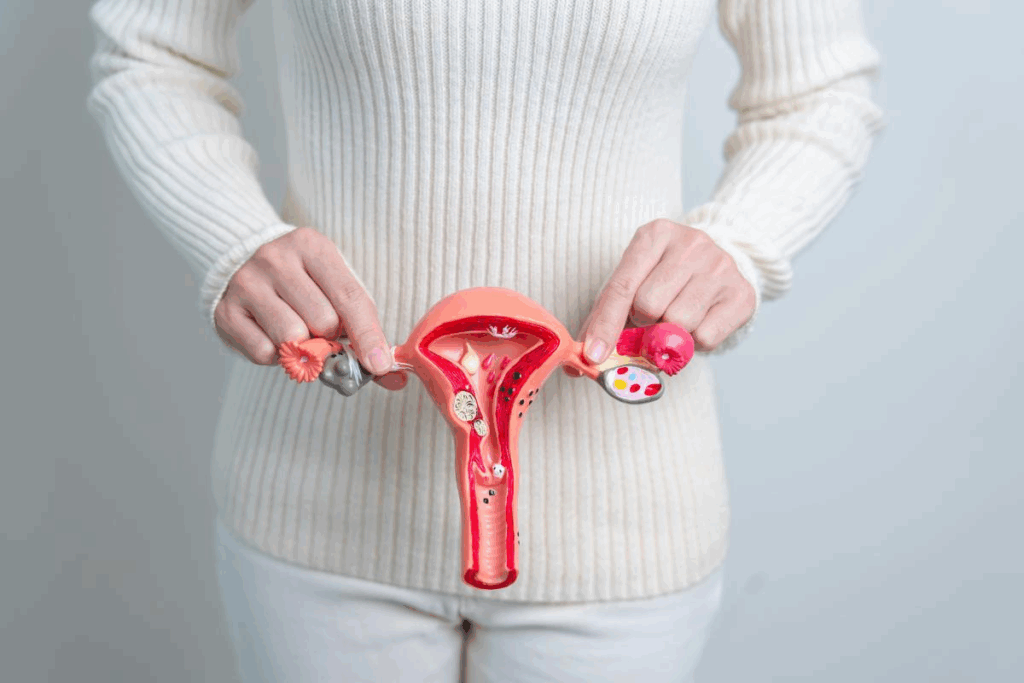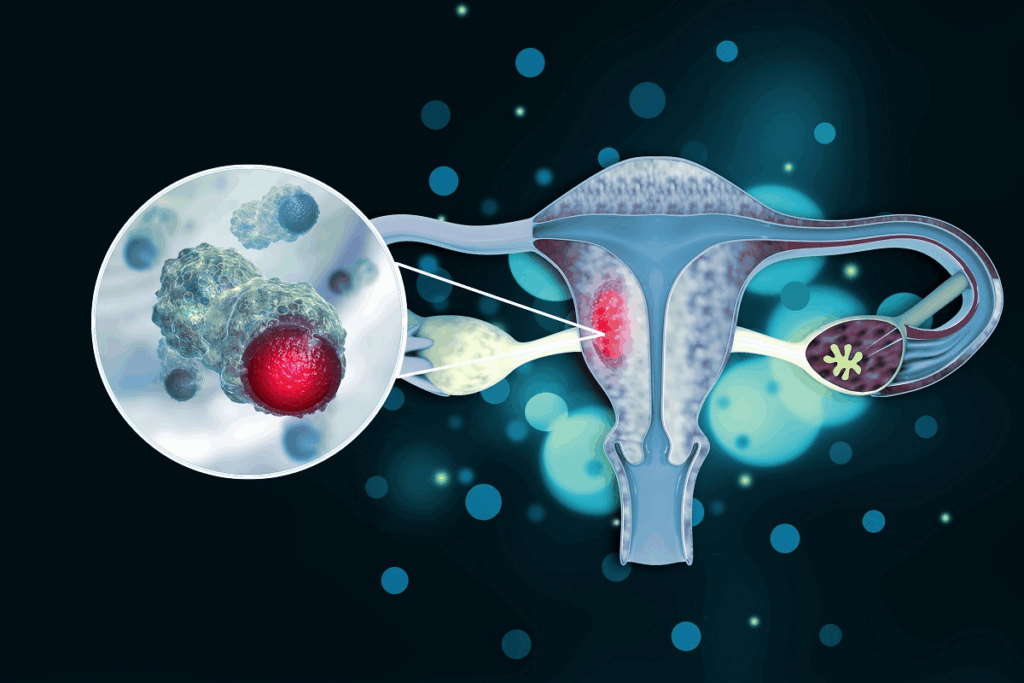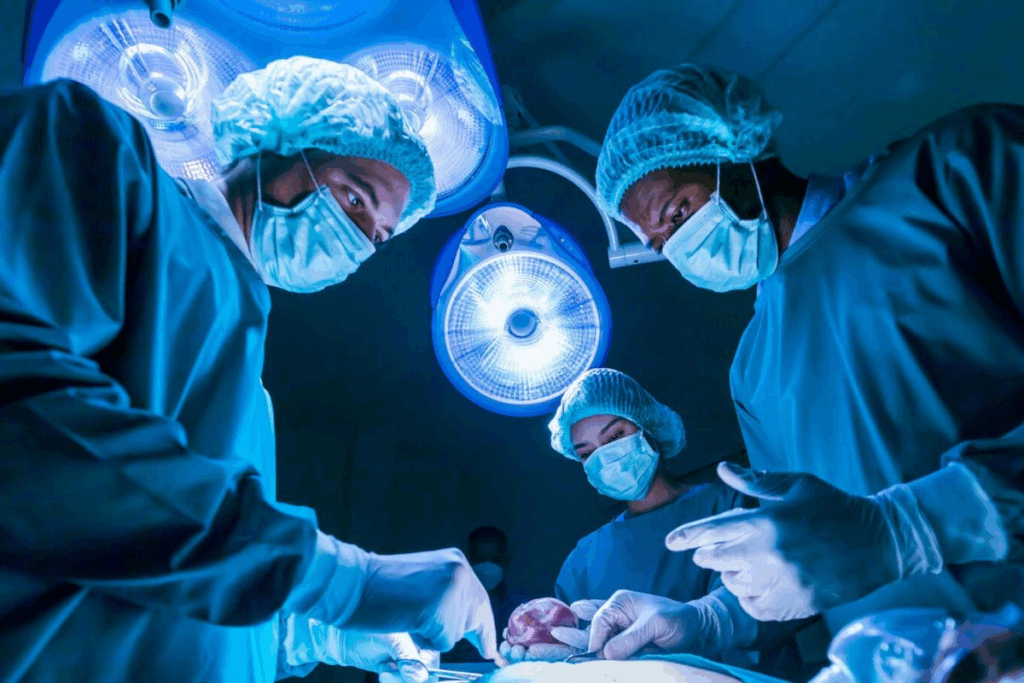Last Updated on October 31, 2025 by Saadet Demir

Dealing with large uterine fibroids can be tough. Finding the right treatment is key. At Liv Hospital, we offer top-notch, patient-focused care. We know that treatment for uterine fibroids depends on the fibroids’ size, number, and where they are, and the symptoms they cause. Need large uterine fibroid removal? Discover the 7 best and most effective treatments, from surgery to non-invasive options.
We’ll look at the seven best treatments and remedies. This includes surgical options like hysterectomy for enlarged uterus and fibroids and other fibroid removal methods. Our aim is to give you a detailed look, based on the latest research and expert advice, to help you feel better.

Uterine fibroids, also known as leiomyomas, are benign tumors that grow in or around the uterus. They often cause discomfort and health issues. These growths are common among women of reproductive age, affecting each person differently.
Uterine fibroids are non-cancerous growths that can develop in or on the uterus. They vary in size, number, and location. Hormonal factors, like estrogen, play a big role in their growth. The Mayo Clinic says the exact cause is not fully understood, but genetics, hormones, and environment may influence them.
Key characteristics of uterine fibroids include:
Large uterine fibroids can cause a range of symptoms, including:
These symptoms can significantly impact a woman’s quality of life. It’s important to seek medical attention if they persist or worsen over time.
“The symptoms caused by uterine fibroids can be debilitating, affecting not just the physical health but also the emotional well-being of women.”
Diagnosing uterine fibroids typically involves a combination of the following methods:
| Diagnosis Method | Description |
| Pelvic Exam | A physical examination to assess the size and shape of the uterus |
| Ultrasound | Imaging test using sound waves to visualize the uterus and fibroids |
| MRI or CT Scan | Detailed imaging tests to determine the size, number, and location of fibroids |
| Hysteroscopy | A procedure to visually examine the inside of the uterus |
Accurate diagnosis is key for finding the best treatment for uterine fibroids. Treatments can range from surgery to non-surgical options, or a mix of both.

Surgery to remove large uterine fibroids offers several methods, each with its own advantages and considerations. The right surgery depends on the fibroid’s size and location, the patient’s health, and if they want to keep their fertility.
A myomectomy removes fibroids but keeps the uterus. It’s a good choice for women who want to keep their fertility. There are different types of myomectomy, each for different fibroid sizes and locations.
Benefits of Myomectomy: It keeps the uterus, may help with fertility, and relieves symptoms like heavy bleeding and pain.
A hysterectomy removes the uterus and is a final solution for fibroids. It’s often chosen for women with big fibroids or who don’t want more children. There are various ways to do a hysterectomy, like abdominal, laparoscopic, and robotic-assisted.
| Type of Hysterectomy | Description | Recovery Time |
| Abdominal Hysterectomy | Uses a big incision in the belly to remove the uterus. | 6-8 weeks |
| Laparoscopic Hysterectomy | Uses small incisions and a camera for a less invasive approach. | 3-4 weeks |
| Robotic-Assisted Hysterectomy | Uses robotic tools for precise removal. | 3-4 weeks |
Laparoscopic and robotic surgery have changed gynecology, making surgeries less invasive. They lead to smaller cuts, less blood loss, and faster healing than open surgery.
There are many ways to surgically remove large uterine fibroids, each suited to the patient’s needs. Knowing the benefits and risks of each option is key to making a good choice.
Non-surgical treatments are becoming more popular for dealing with uterine fibroids. They offer relief without the need for surgery. These options are great for women who want to avoid surgery.
Uterine Fibroid Embolization is a minimally invasive method. It cuts off the blood supply to fibroids, causing them to shrink. UFE involves injecting embolic material into the arteries that supply blood to the fibroids, reducing their size and easing symptoms.
The benefits of UFE include:
MRI-Guided Focused Ultrasound is a non-invasive treatment. It uses sound waves to heat and destroy fibroid tissue. This procedure is guided by MRI imaging, allowing for precise targeting of the fibroids.
The advantages of MRI-Guided Focused Ultrasound include:
Radiofrequency Ablation uses heat from radiofrequency waves to shrink or destroy fibroids. This technique is minimally invasive and can be effective in reducing fibroid size and associated symptoms.
The benefits of Radiofrequency Ablation include:
These non-surgical procedures offer women a range of options for treating uterine fibroids. Each has its own benefits and considerations. It’s important to talk to a healthcare provider to find the best treatment for your needs and health status.
Hormonal treatments are a promising way to shrink fibroids and ease symptoms. They target the hormones that make fibroids grow. This is a non-surgical option for many women.
GnRH agonists and antagonists are drugs that can make fibroids smaller. The Mayo Clinic says they can shrink fibroids by up to 60% in three months. But, they’re only used for a short time because of side effects like bone loss and menopause symptoms.
Benefits and Limitations: These drugs can greatly reduce fibroid size and symptoms like heavy bleeding and pain. But, they’re only used for 3-6 months and can have serious side effects.
SPRMs work on the progesterone receptor, which helps fibroids grow. They can make fibroids smaller and reduce bleeding without causing big drops in estrogen levels.
“SPRMs represent a promising therapeutic option for managing fibroids, balancing safety and effectiveness.” –
Dr. Elizabeth Stewart, Mayo Clinic
Clinical Evidence: Research shows SPRMs can cut down on menstrual bleeding and improve life quality for women with fibroids.
Progestin-releasing IUDs are another hormonal treatment for fibroid symptoms. They release progestin, which can lessen menstrual bleeding and other symptoms.
| Treatment | Mechanism of Action | Benefits |
| GnRH Agonists/Antagonists | Create temporary menopausal state | Significant reduction in fibroid size, alleviates symptoms |
| SPRMs | Act on progesterone receptors | Reduces fibroid size and bleeding, fewer side effects |
| Progestin-Releasing IUDs | Release progestin locally | Reduces menstrual bleeding, alleviates symptoms |
In conclusion, hormonal treatments offer many options for shrinking fibroids and managing symptoms. By learning about these treatments, women can make better choices for their care.
Fibroids can cause a lot of discomfort. Luckily, there are many medicines to help with these symptoms. These drugs don’t get rid of fibroids but can ease heavy bleeding, pain, and other problems.
Tranexamic acid is made to control heavy menstrual bleeding from fibroids. It helps by making blood clots more stable and reducing bleeding. The Mayo Clinic says it works best in the first few days of your period when bleeding is heaviest.
Key benefits of tranexamic acid include:
Nonsteroidal anti-inflammatory drugs (NSAIDs) help with fibroid pain. They work by cutting down inflammation and blocking pain signals. Even though they don’t fix the root cause, NSAIDs can really help with pain.
Common NSAIDs used for fibroid pain include:
Heavy bleeding from fibroids can cause iron deficiency anemia. Iron supplements can stop or treat this by adding iron to your body. Always talk to a doctor before starting iron supplements to find the right amount.
Benefits of iron supplements include:
Knowing about these medicines can help women with fibroids manage their symptoms better. It’s important to talk to a doctor to find the best treatment plan.
Medical treatments are key for fibroid management. But, natural remedies and lifestyle changes can also help. We’ll look at how these can ease fibroid symptoms and maybe even shrink them.
An anti-inflammatory diet is full of fruits, veggies, and omega-3s. It fights inflammation linked to fibroids. Eating leafy greens, berries, and fatty fish can help. Avoid processed foods, sugars, and saturated fats to reduce inflammation.
Nutritional Tips:
Regular exercise and a healthy weight are key for fibroid management. Exercise lowers estrogen, which can slow fibroid growth. Yoga, brisk walking, and swimming are great for health and symptom relief.
Benefits of Exercise:
Chronic stress worsens hormonal imbalances and fibroid symptoms. Stress-reducing activities like meditation, deep breathing, or mindfulness help. Enjoying hobbies and relaxation activities also boosts well-being.
Stress Management Strategies:
Adding natural remedies and lifestyle changes can help manage fibroid symptoms. It might even shrink them. Always talk to a healthcare provider before making big changes to your lifestyle or treatment plan.
There are more ways to handle fibroids than just traditional treatments. Many women are looking for natural ways to ease their symptoms and live better lives.
Herbal supplements are becoming more popular for fibroid relief. Some studies show they might shrink fibroids and lessen symptoms like heavy bleeding and pain.
Even though these supplements look promising, talk to a doctor before trying them. They can affect other medicines or cause side effects.
“The use of herbal supplements for fibroid management is an area of growing interest. More research is needed to fully understand their effectiveness and possible risks.”
Dr. Jane Smith, OB-GYN Specialist
Acupuncture is a big part of Traditional Chinese Medicine (TCM). It involves putting thin needles in certain body points to heal and balance. Some women say acupuncture helps with fibroid symptoms.
| Therapy | Potential Benefits |
| Acupuncture | Reduces pain, regulates menstrual cycles |
| Herbal Medicine | May reduce fibroid size, alleviate symptoms |
TCM treats the whole person, not just symptoms. This approach can help women get better care for their fibroids.
Castor oil packs are a common home remedy for fibroids. People think castor oil can reduce inflammation and heal when applied to the belly.
Other home remedies for fibroid symptoms include:
These remedies are usually safe, but how well they work can vary. More research is needed to confirm their benefits for fibroids.
Severe bleeding from fibroids is a serious issue. It’s important to know the emergency steps to take. Heavy bleeding from fibroids is not just uncomfortable; it can be life-threatening.
The Mayo Clinic says fibroid bleeding can cause serious health problems if not treated quickly. “Heavy menstrual bleeding from fibroids can lead to anemia and other serious issues.”
For sudden bleeding from fibroids, medical help is key. Tranexamic acid is often given to control heavy bleeding. It helps by making blood clots more stable and reducing bleeding.
Other treatments might include:
Knowing when to go to the emergency room is critical. If you have symptoms like these, get help right away:
Quick action can prevent serious problems, like severe anemia and the need for more serious treatments.
After emergency treatment for fibroid bleeding, follow-up care is essential. This may include:
Healthcare providers stress the need for follow-up care. It helps ensure bleeding is controlled and deals with fibroid issues.
Understanding emergency treatments and knowing when to seek help can help women manage fibroid bleeding. This improves their quality of life.
Uterine fibroids can be tough to handle, but the right plan can help. We’ve looked at many ways to treat them, like surgery and non-surgical methods, hormonal treatments, and lifestyle changes.
The Mayo Clinic says making a personalized treatment plan is key. It means looking at your fibroids’ size and location, your symptoms, and your health. This way, women can choose the best care for themselves.
To remove fibroids or ease symptoms, talk to a healthcare expert. They’ll help you decide the best treatment for uterine fibroids. They’ll consider the pros and cons of each option and create a plan just for you.
Knowing about the treatments and working with a healthcare provider is important. This way, you can make a plan to get rid of fibroids and feel better. Whether you choose surgery or another method, a personalized treatment plan is essential for the best results.
For large uterine fibroids, the best treatments are surgery and non-surgical methods. Surgery includes myomectomy and hysterectomy. Non-surgical options are uterine fibroid embolization (UFE) and MRI-guided focused ultrasound.
Yes, you can treat fibroids without surgery. UFE, MRI-guided focused ultrasound, and radiofrequency ablation can shrink or remove fibroids. These methods are less invasive than surgery.
Shrinking fibroids naturally is not guaranteed. But, some women find relief with lifestyle changes. These include an anti-inflammatory diet, exercise, managing weight, and stress reduction.
Tranexamic acid helps manage heavy bleeding from fibroids. It stabilizes blood clots, reducing bleeding.
Yes, hormonal treatments can shrink fibroids. GnRH agonists and antagonists, SPRMs, and progestin-releasing IUDs help by balancing hormones.
Laparoscopic and robotic-assisted surgery have many benefits. They use smaller incisions, cause less blood loss, and lead to quicker recovery. This is compared to traditional open surgery.
To stop heavy bleeding, medical treatments like tranexamic acid and hormonal therapies are used. In emergencies, procedures like D&C may be needed. Always seek immediate medical help for severe bleeding.
Yes, alternative therapies like herbal supplements, acupuncture, and traditional Chinese medicine may help. But, their effectiveness varies. Always talk to a healthcare provider before trying them.
Yes, a hysterectomy can remove fibroids. It’s a definitive treatment for severe symptoms or large fibroids. It involves removing the uterus.
Lifestyle changes can help manage symptoms. Maintaining a healthy weight, following an anti-inflammatory diet, exercising, and reducing stress are key. These changes can improve your quality of life.
Subscribe to our e-newsletter to stay informed about the latest innovations in the world of health and exclusive offers!
WhatsApp us